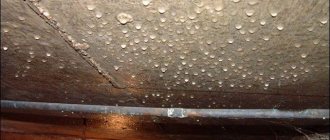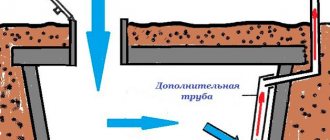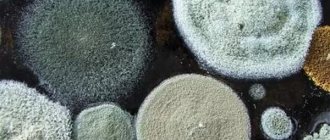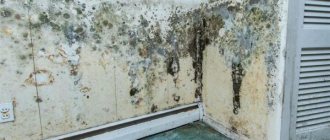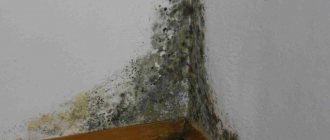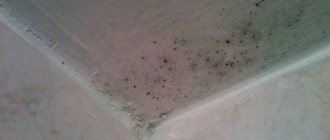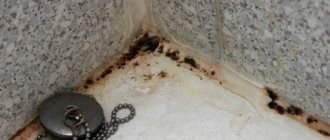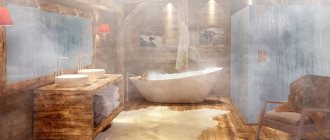Human sensations when humidity changes
In the summer, excessive moisture has a negative impact on people's health. Air masses contain large amounts of moisture. As the temperature increases, they “absorb” water. The person has difficulty breathing and his blood pressure may increase. In winter, as temperatures decrease, humidity decreases. The body begins to give off heat. The importance of humidity in human life cannot be overestimated.
If the external temperature is high, but the composition of the air masses is characterized by a low moisture content, the heat can be tolerated quite easily. When the values of this parameter increase, a person may experience unpleasant conditions:
- body temperature rises;
- weakness and headache appear;
- pulse quickens;
- breathing becomes more frequent;
- There is profuse sweating.
In the presence of low temperature and high humidity, the human body, on the contrary, will become hypothermic. In order for living conditions to be comfortable, the percentage of moisture should be in the range of 30-60%. Otherwise, health problems may arise. The skin dries out and the body becomes dehydrated. Dry mucous membranes allow the penetration of pathogenic viruses and bacteria.
Air humidity plays a huge role for humans. High moisture content leads to increased heat transfer. The body can quickly overheat. With prolonged exposure to such an environment, immunity decreases. There is an exacerbation of heart disease, hypertension and atherosclerosis. This situation has a negative impact not only on the human body. The appearance of dampness contributes to the accelerated proliferation of fungal formations. Building structures are being destroyed. Furniture and interior items deteriorate.
The influence of microclimate on the human body:
The microclimate of the production premises has a significant impact on the worker. Deviation of individual microclimate parameters from the recommended values reduces performance, worsens the employee’s well-being and can lead to occupational diseases.
Air temperature. Low temperatures cool the body and can contribute to the occurrence of colds. At high temperatures - overheating of the body, increased sweating and decreased performance. The worker loses attention, which can lead to an accident.
Increased air humidity makes it difficult to evaporate moisture from the surface of the skin and lungs, which leads to disruption of the body's thermoregulation, deterioration of a person's condition, and decreased performance. With low humidity (<20%) – dryness of the mucous membranes of the upper respiratory tract.
Air speed. A person begins to feel air movement at v » 0.15 m/sec. The movement of the air flow depends on its temperature. At t < 36°C, the flow has a refreshing effect on humans; at t > 40°C, it has an unfavorable effect.
Prevention of adverse effects of microclimate
Activities aimed at improving microclimate conditions are regulated by “Sanitary rules for the organization of technological processes and hygienic requirements for production equipment.” The fight against the adverse effects of the industrial microclimate is carried out using measures of a technological, sanitary-technological, organizational and medical-preventive nature.
Technological measures play a leading role in preventing the harmful effects of high temperatures of infrared radiation. Replacing old ones and introducing new technological processes and equipment contribute to the improvement of unfavorable working conditions. Automation and mechanization of processes, remote control provide the opportunity for workers to stay away from the source of radiation and convection heat.
The group of sanitary measures includes localization of heat emissions, thermal insulation of hot surfaces, shielding of sources or workplaces, general ventilation or air conditioning.
Measures to ensure the tightness of the equipment help reduce the flow of heat into the workshop. Tightly fitted doors, dampers, blocking the closure of technological openings with the operation of equipment - all this significantly reduces the release of heat from open sources.
Thermal insulation of the surfaces of radiation sources (furnaces, vessels and pipelines with hot gases and liquids) reduces the temperature of the radiating surface and reduces heat generation. For example, thermal insulation of the walls of thermal furnaces, which reduces their surface temperature from 130 to 80 ° C, reduces heat generation by 5 times.
Heat-reflective screens are used to localize heat release from the surface of furnaces, to cover the outer surfaces of control station cabins and cranes. For heat-absorbing screens, various types of glass are used: silicate, quartz, organic. These transparent screens are used to protect crane operators in hot shops and control station operators from thermal radiation. For open sources of radiation (furnace windows, observation windows of control stations in hot shops), it is advisable to use water screens, since a mirror water curtain reduces the radiation intensity by 5-10 times.
Organizational and medical preventive measures:
An important factor contributing to increasing the efficiency of workers in hot shops is a rational work and rest regime. It is developed in relation to specific operating conditions. Frequent short breaks are more effective in maintaining performance than rare, long ones.
For moderate physical work and outdoor temperatures up to 25°C, the intra-shift regime provides for 10-minute breaks after 60-50 minutes of work; at outdoor temperatures from 25 to 33 °C, 15-minute breaks after 45 minutes of work and a 4-5 hour shift break during the hottest period are recommended. In hot climates, it is proposed to start the working day earlier, and take breaks during the hottest hours (from 12 to 18 o'clock). For short-term work in conditions of high temperatures (extinguishing underground fires, repairing metallurgical furnaces), where the temperature is 80-100 °C, thermal training is of great importance.
Resistance to high temperatures can be increased to some extent using pharmacological agents (taking dibazole, ascorbic acid, a mixture of these substances and glucose), inhaling oxygen, and aeroionization. Drinking regimen is essential for the prevention of overheating, as discussed above.
Personal protective equipment plays a significant role in preventing overheating. Overalls should be air- and moisture-permeable (cotton, linen, coarse wool cloth), and have a comfortable cut. To protect against infrared radiation, reflective fabrics are used, on the surface of which a thin layer of metals is sprayed. To work in extreme conditions (fighting fires, etc.), special suits with increased heat and light output are used. To protect the head from radiation, duralumin, fiber helmets, and felt hats are used; to protect the eyes - glasses (dark or with a transparent layer of metal), masks with a folding screen. When working outdoors, awnings and canopies are provided at permanent workplaces. The car cabins are painted in light colors, equipped with air conditioning, and thermally insulated.
Contraindications to employment under conditions of exposure to high temperatures and infrared radiation are organic diseases of the cardiovascular system, kidneys, stomach, skin, and ovarian-menstrual dysfunction.
Measures to prevent the adverse effects of cold should include heat retention. To prevent cooling of industrial premises, sanitary standards regulate the construction of gates, openings - air curtains, airlocks, double glazing of windows, thermal insulation of floors and walls. In large workshops at workplaces, the microclimate is maintained by local heating - air or radiation (local radiant).
For non-fixed workplaces (work in refrigerators) and work outdoors in cold climate zones, special heating rooms with a temperature of 21-23° C are organized.
In the fight against cooling, a rational regime of work and rest is very important. Under unfavorable meteorological conditions - air temperature -10 °C and below - heating breaks of 10-15 minutes every hour are required. At outdoor temperatures from -30 to -45 °C, 15-minute rest breaks are organized 60 minutes from the start of the work shift and after lunch, and then every 45 minutes of work. In heating rooms it is necessary to provide the possibility of drinking hot tea. After working in refrigerated rooms, it is advisable to take a water shower at 38-40 °C.
Personal protective equipment is of great importance in preventing the body from cooling down. Clothing materials must have good heat-protective properties (fur, wool, sheepskin, cotton wool, synthetic fur). When working in extreme temperatures, the use of multi-layered and electrically heated clothing is recommended.
In order to prevent cooling and increase resistance to the effects of cold, it is recommended to harden the body through hydrotherapy, air and sun baths, and increase the body's resistance with the help of UV irradiation and physical exercise.
Medical contraindications to working in cold conditions are diseases of the endocrine glands, metabolic diseases, hematopoietic organs, chronic diseases of the respiratory tract, kidneys, peripheral vessels, joints, etc.
Head of the industrial and sanitary laboratory of the Federal State Budgetary Institution of Health Central Hygiene and Epidemiology No. 28 of the FMBA of Russia Evgeniy Aleksandrovich Sotnikov
The impact of changes in air moisture content on furniture and household items
Not only our well-being depends on the composition of air masses. The value of humidity in everyday life is subject to special consideration. Wood products react very subtly to changes in the percentage of moisture content. The condition of furniture, interior structures and musical instruments is deteriorating. With high humidity, wooden coverings become deformed and change their shape.
Dry air is no less dangerous for household items. This becomes especially noticeable when cold weather sets in and the central heating is turned on:
- the furniture surface is cracking;
- the parquet begins to delaminate;
- musical instruments are more difficult to tune.
Dry air negatively affects the condition of artistic works of art. The paint is peeling off the surface of the paintings. That is why special devices are installed in large museums and exhibition halls that record changes in the composition of air masses.
How to increase humidity in an apartment
So, based on the results of experiments and measurements, you have come to the conclusion that the humidity in the room is low. Don't be upset, this flaw is easier to fix than the opposite case. There are several ways - expensive and not very expensive, for every taste and budget.
- Buy a humidifier. There is a huge range of these devices on the market. Depending on the price, they are equipped with various options. For example, models with a built-in hygrometer automatically turn on when humidity drops and turn off when optimal values are restored. Many of them give signals when there is no water in the storage tank. More advanced models can immediately clean, disinfect and ionize the air. Modern ultrasonic humidifiers operate almost silently, and the smallest droplets of water vapor do not hang like a heavy fog in the apartment.
- Buy an aquarium. With this purchase you will kill two birds with one stone - the grumbling hare (about low humidity in the apartment) and the esthete hare. Firstly, the aquarium is beautiful, and the serene movement of the fish in it is calming. That's what psychologists say. If you don’t have the time or desire to feed the fish, leave only the algae there. There are interior solutions that do not require constant water changes and careful care of the inhabitants. And if the humidity begins to exceed the required levels, you can always cover the aquarium with a lid specially designed for this.
- Buy a decorative fountain with a pump. This device will circulate just a couple of liters of water in a circle. But the evaporation that is formed in this case can humidify the room quite well. The device must be turned off periodically. As they say, if you have a fountain, shut it up and give the fountain a rest.
- After visiting the bathroom, leave the door open until the moisture from it is distributed throughout the apartment;
- Dry your clothes in the room. And the towels are on radiators. Yes, it doesn’t look very aesthetically pleasing, but as an urgent measure it’s quite acceptable.
- Get indoor plants (preferably not cacti) and water them as the soil dries out. The need to regularly spray the leaves with water will help improve the microclimate of the apartment.
- Try not to use electrical appliances to heat your apartment in winter. When heating is turned on, the humidity level already drops significantly, and when using electric heaters it drops to catastrophically low levels. Use infrared and ceramic heaters to increase the temperature in your apartment. They do not burn oxygen and, according to manufacturers, do not significantly reduce indoor humidity.
Humidity and metrology
Water covers the entire surface of the earth. It is found in any living organism. The atmospheric composition includes 15,000 km3 of moisture. It represents the following formations:
- water drops;
- snow crystals;
- water vapor
The amount of water vapor affects weather and climate conditions. Oceans, seas, lakes and rivers occupy a huge area. Despite this, the water content in the atmosphere over different parts of the planet is not the same. As a result of the movement of air in certain places on the earth's surface, the liquid evaporates faster than its condensation occurs.
Humidity in meteorology is characterized using several parameters:
- Absolute humidity refers to the density of water vapor contained in air masses;
- what is called relative air humidity is the ratio of the pressure that water vapor creates at certain temperatures to the vapor pressure in a saturated state.
Relative humidity, in other words, shows the level of saturation of water vapor.
How to measure humidity in an apartment?
To measure humidity, you can use both precision instruments and folk remedies. In the latter case, you will not receive a quantitative value of the humidity level in the apartment, but you can evaluate qualitatively - the level is increased, decreased or normal. So, to measure the degree of humidity in an apartment, you can use the following measuring instruments:
- psychrometric hygrometer.
It sounds scary, but in fact it is a well-known mechanical device with two thermometers. One of them shows the room temperature, and the other shows the humidity. How does he work? The second thermometer is connected to a fabric cord, which is located in a small reservoir of water. During the process of evaporation of moisture, the thermometer column shows the humidity parameter that corresponds to the current intensity of evaporation. The higher the humidity in the room, the less active the evaporation process occurs, and vice versa. In order not to waste time pronouncing the full name of the device, it is called briefly - psychrometer. It looks like a regular wall thermometer, only doubled.
- hair hygrometer.
One of the most accurate hygrometers invented to date. Detects humidity in the range from 0 to 100%. It is a dial with humidity values and an arrow printed on it. One end of the arrow is connected to a thin synthetic fat-free hair. The other end of the hair is attached to a special spring. The principle of operation is based on the ability of the hair to change length under conditions of different humidity. The length of the hair changes, the spring is tightened or weakened, the arrow shows the desired value on the dial. The device is accurate and practically eternal. Simplicity of design, reliability in operation and accuracy of readings - this is an ideal device. And it will fit into any interior.
- film hygrometer.
The principle of working with hair is similar. The organic film also changes its size depending on the degree of humidity of the surrounding atmosphere. When the marked point of the film center is shifted, the instrument's performance changes. But he looks specific. Not everyone wants to have a branch of a physics laboratory in their apartment. And the likelihood of mechanical damage is high if there are children in the house.
- electronic hygrometer.
It is a portable weather station. It immediately measures the temperature inside the room, outside the window, as well as the air humidity outside and in the apartment. Requires regular replacement of batteries, and may slightly distort the information if, for example, street sensors are installed incorrectly. Some of the electronic weather stations are equipped with an alarm if the humidity readings are not optimal.
Methods for measuring moisture content
Moisture content can be determined using various measuring instruments:
- The psychometric device includes alcohol thermometers – “dry” and “wet”. Using the temperature difference and a lookup table, calculate the relative humidity;
- The device with weighing structure contains u-shaped tubes and adsorbent material. The air being tested passes through it. When pumping air mass, the weight of the material increases or decreases. Based on its change, the percentage of moisture is determined;
- Relative humidity is measured using hair and film hygrometers;
- for ceramic devices, the resistance changes with an increase or decrease in air composition;
- In a condensation gyroscope, the temperature of condensate on a mirror surface is measured. It is pre-cooled. The resulting value is compared with the ambient temperature.
An air humidity table is used to measure moisture content using dry-bulb and wet-bulb thermometers. The temperature difference corresponds to the relative humidity value.
The influence of microclimate on children's health
Experts have proven not only the influence of microclimate on the performance of adults, but also its impact on the health of children. If a child is in an environment with insufficient air humidity, he or she develops a dry cough, cracked lips, impaired breathing and sense of smell, and a sore throat. The condition leads to the development of respiratory diseases, insomnia; causes weakening of the immune system. Children do not master the preschool or school curriculum; they are lethargic, weakened, malnourished, and apathetic.
If parents do not promptly adjust their living conditions, the child’s risk of developing neurological and digestive disorders increases. Providing a room with a properly functioning ventilation system in a timely manner can prevent the development of adverse health outcomes.
Folk signs
When the weather changes, the moisture content in the air mass changes. Folk signs related to air humidity say that if clear and dry weather is expected, smoke from the stove will rise vertically. Before it rains, it spreads along the surface of the earth.
If there is severe frost and dry air, the wood in the stove burns with a bright flame and burns out in a short time. With a pale, dim flame, a large amount of soot produced and insufficient draft, there is a high probability of high moisture content in the air masses.
In the evening, in the absence of wind, the air temperature drops. Above the ground you can often see vaporous moisture - fog. You can also judge the upcoming weather by his behavior. According to signs, rising fog indicates future rain. If it lies on the surface of the ground, dry weather can be expected. Night and morning fog in the valley, which disappears with sunrise, indicates good weather ahead. The same forecast can be made in the presence of heavy morning dew.
If the moisture content in the air masses increases, many flowers experience contraction of inflorescences. The smell of rowan becomes sharper. Coniferous trees have drooping branches. When the air is dry they rise.
The moisture content in air masses is an important parameter that affects the human body and the entire environment.
The influence of microclimate on health and performance
Working ability directly depends on the state of health, and it is determined by the conditions in which a person lives and works. If it is in conditions of high or low air temperature, this harms the body, as it becomes overheated or hypothermic. In the first case, the following symptoms appear:
- Frequently recurring headaches.
- Nausea, vomiting.
- Facial redness.
- Intense sweating.
- Increased pressure level.
- Weakness.
- Impaired coordination of movements.
The listed signs indicate the development of heat stroke, which is dangerous for the development of stroke, myocardial infarction, dehydration, hypovitaminosis, hypoxia and other disorders. The high temperature of the air flows indoors contradicts the sufficient saturation of the body with oxygen. Its deficiency leads to disruption of brain activity, which is expressed in weakened concentration, memory, speech, coordination, and thinking. Among other reasons, overheating of the body contributes to an increase in the thickness of the blood - it collects in blood clots and circulates heavily inside the veins, capillaries, and arteries. Staying in low air temperatures leads to hypothermia. This condition is dangerous due to the development of infectious and inflammatory diseases and a decrease in the protective properties of the body. With regular hypothermia, first of all, the joints and kidneys suffer, which, if left untreated, takes on a chronic form and leads to disability.
The level of air humidity decreases with excessively intensive operation of heating devices. The mucous membranes of the nose dry out, which causes inflammation. Other consequences of insufficient air humidity levels:
- Increased blood viscosity, predisposition to the formation of life-threatening blood clots.
- Impaired kidney function, up to failure of this paired organ.
- Slow bowel activity, difficulty digesting food, weight gain.
- Failure in the functioning of the heart, predisposition to the development of coronary disease, myocardial infarction.
- Deterioration in general health – increased fatigue, irritability, mood swings.
- Decreased immunity, tendency to develop various infectious and inflammatory diseases.
The listed symptoms indicate the emergence of health problems and serve as the basis for immediate action. The main method of ensuring the required microclimate parameters is the use of multifunctional ventilation systems.
A high level of humidity in air flows inside a residential or industrial premises contributes to the development of diseases of the respiratory and urinary system. The risk of bronchitis and kidney pathologies increases, which quickly become chronic, harm health, and reduce quality of life.
Why does heat stroke occur and what are its symptoms?
Heat stroke [Official source] occurs due to overheating of the body. This happens if there is an interaction between two factors - high air temperature and high air humidity, at which heat transfer is impossible.
Heat stroke is accompanied by obvious symptoms:
- body temperature rises to 39-40° and above;
- the skin becomes dry, hot and red;
- weakness, lethargy appears;
- dizziness, nausea, vomiting;
- breathing becomes more frequent, shortness of breath appears;
- pulse weakens and becomes frequent;
- convulsions and muscle spasms may occur;
- in the most severe cases, hallucinations and fainting may occur.
This condition requires an urgent call for an ambulance. The first aid to a person is to try to cool the body as much as possible.



